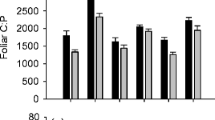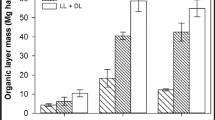Abstract
A ponderosa pine/Douglas-fir forest (Pinus ponderosa Dougl., Pseudotsuga menziesii (Mirb.) Franco; PP/DF) and a lodgepole pine/Engelmann spruce forest (Pinus contorta Loud., Picea engelmannii Parry ex Engelm.; LP/ES) located on the eastern slopes of the Cascade Mountains in Washington state, USA, were examined following severe wildfire to compare total soil carbon and nitrogen capitals with unburned (control) forests. One year after fire, the average C content (60 cm depth) of PP/DF and LP/ES soil was 30% (25 Mg ha-1) and 10% (7 Mg ha-1) lower than control soil. Average N content on the burned PP/DF and LP/ES plots was 46% (3.0 Mg ha-1) and 13% (0.4 Mg ha-1) lower than control soil. The reduction in C and N in the PP/DF soil was largely the result of lower nutrient capitals in the burned Bw horizons (12–60 cm depth) relative to control plots. It is unlikely that the 1994 fire substantially affected nutrient capitals in the Bw horizons; however, natural variability or past fire history could be responsible for the varied nutrient capitals observed in the subsurface soils. Surface erosion (sheet plus rill) removed between 15 and 18 Mg ha-1 of soil from the burned plots. Nutrient losses through surface erosion were 280 kg C ha-1 and 14 kg N ha-1 in the PP/DF, whereas LP/ES losses were 640 and 22 kg ha-1 for C and N, respectively. In both forests, surface erosion of C and N was ∼1% to 2% of the A-horizon capital of these elements in unburned soil. A bioassay (with lettuce as an indicator plant) was used to compare soils from low-, moderate- and high-severity burn areas relative to control soil. In both forests, low-severity fire increased lettuce yield by 70–100% of controls. With more severe fire, yield decreased in the LP/ES relative to the low-intensity burn soil; however, only in the high-severity treatment was yield reduced (14%) from the control. Moderate- and high-severity burn areas in the PP/DF were fertilized with ∼56 kg ha-1 of N four months prior to soil sampling. In these soils, yield was 70–80% greater than the control. These results suggest that short-term site productivity can be stimulated by low-severity fire, but unaffected or reduced by more severe fire in the types of forests studied. Post-fire fertilization with N could increase soil productivity where other environmental factors do not limit growth.
Similar content being viewed by others
References
Andreu V, Rubio J L, Forteza J and Cerni R 1996 Postfire effects on soil properties and nutrient losses. Int. J. Wildland Fire 6(2), 53–58.
Agee, J K 1993 Fire Ecology of Pacific Northwest Forests. Island Press, Washington, DC, USA 493 p.
Amaranthus, M P and Trappe J M 1993 Effects of erosion on ecto-and VA-mycorrhizal innoculum potential of soil following forest fire in southwest Oregon. Plant and Soil 150, 41–49.
Beieler V E 1975 Soil survey of Chelan area, Washington: Parts of Chelan and Kittitas Counties. USDA Soil Conser. Serv. and Wash. Agric. Exp. Stn., US Govt. Print. Office, Washington, DC, USA.
Binkley D, Richter D, David M B and Caldwell B 1992 Soil chemistry in a loblolly/longleaf pine forest with interval burning. Ecol. App. 2(2), 157–164.
Brockley R P, Trowbridge R L, Ballard T M and Macadam A M 1992 Nutrient management in interior forest types. In Forest Fertilization: Sustaining and Improving Nutrition and Growth in Western Forests. Institute of Forest Resources Contribution No. 73 pp 43–64. College of Forest Resources, Univ. of Washington, Seattle, WA, USA.
Busse M D 1994 Downed bole-wood decomposition in lodgepole pine forests of central Oregon. Soil Sci. Soc. Am. J. 58, 221–227.
Campbell R E, Baker MB Jr, Ffolliot P F, Larson F R and Avery C C 1977 Wildfire effects on a ponderosa pine ecosystem: an Arizona case study. USDA For. Serv. Res. Pap. RM-191.
Christensen N L 1973 Fire and the nitrogen cycle in California chaparral. Science 181, 66–68.
Chorover J, Vitousek P M, Everson D A, Esperanza A M and Turner D 1994 Solution chemistry profiles of mixed-conifer forests before and after fire. Biogeochem. 26, 115–144.
Covington W W and Sackett S S 1992 Soil mineral nitrogen changes following prescribed burning in ponderosa pine. For. Ecol. and Manage. 54, 175–191.
Evans C C and Allen S E 1971 Nutrient losses in smoke produced by heather burning. Oikos 22,149–154.
Fahey T J, Yavitt J B, Pearson J A and Knight D A 1985 The nitrogen cycle in lodgepole pine forests, southeastern Wyoming. Biochem J. 1, 257–275.
Forbes R D and Meyer H B 1955 Forestry Handbook, Society of American Foresters. Ronald Press, New York, NY, USA.
Gholz H L, Grier C C, Campbell A G and Brown A T 1979 Equations for estimating biomass and leaf area of plants in the Pacific Northwest. Forest Research Laboratory, Res. Pap. 41, Oregon St. Univ., Corvallis, OR, USA.
Giovannini G, Lucchesi S and Giachetti M 1990 Effects of heating on some chemical parameters related to soil fertility and plant growth. Soil Sci. 149(6), 344–350.
Grier C C 1975 Wildfire effects on nutrient distribution and leaching in a coniferous ecosystem. Can. J. For. Res. 5, 599–607.
Helvey J D, Tiedemann A R and Anderson T D 1985 Plant and nutrient loss by soil erosion and mass movement after wildfire. J. Soil and Water Conserv. 40(1), 168–172.
Klemmedson J O 1975 Nitrogen and carbon regimes in an ecosystem of young dense ponderosa pine in Arizona. For. Sci. 21(2), 163–168.
Kutiel P and Naveh Z 1987 The effect of fire on nutrients in a pine forest soil. Plant Soil 104, 269–274.
Lillybridge T R, Kovalchik B L, Williams C K and Smith B G 1995 Field guide for forested plant associations of the Wenatchee National Forest. USDA For. Serv. Gen. Tech. Rep. PNW-GTR-359.
Leitch C J, Flinn D W and van de Graaff R H M 1983 Erosion and nutrient loss resulting from Ash Wednesday (February 1983) wildfires: a case study. Aust. For. 46(3), 173–180.
Lopushinsky W, Zabowski D and Anderson T D 1992 Early survival and height growth of Douglas-fir and lodgepole pine seedlings and variations in site factors following treatment of logging residues. USDA For. Serv. Res. Pap. PNW-451.
Nissley S D, Zasoski R J and Martin R E 1980 Nutrient changes after prescribed surface burning of Oregon ponderosa pine stands. In Proc. 6th Conf. on Fire and Forest Meteorology, pp. 214–219. Soc. Amer. Foresters, Washington, DC, USA.
Okanogan National Forest 1996 Okanogan-Methow Highlands Area Soil Survey (draft). USDA For. Serv. PNW Region, Okanogan National Forest, Okanogan, WA, USA.
Prieto-Fernandez A, Villar M C, Carballas M and Carballas T 1993 Short-term effects of wildfire on the nitrogen status and its mineralization kinetics in an Atlantic forest soil. Soil Biol. Biochem. 25(12), 1657–1664.
Radek K J 1997 Soil erosion following wildfires on the Okanogan National Forest-initial monitoring report. Unpublished report, USDA For. Serv., PNW Reg., Okanogan National Forest, Okanogan, WA, USA.
Radke L F, Stith D, Hegg A and Hobbs P V 1978 Airborne studies of particles and gasses from forest fires. J. Air Pollut. Contr. Assoc. 28, 30–34.
Raison R J, Khanna P K and Woods P V 1985 Mechanisms of element transfer to the atmosphere during vegetation fires. Can. J. For. Res. 15, 132–140.
Rashid G H 1987 Effects of fire on soil carbon and nitrogen in a Mediterranean oak forest of Algeria. Plant Soil 103, 89–93.
Russell J D, Fraser A R, Watson J R and Parsons J W 1974 Thermal decomposition of protein in soil organic matter. Geoderma 11, 63–66.
Scott D F and Van Wyk D B 1990 The effects of wildfire on soil wet-tability and hydrological behaviour of an afforested catchment. J. Hydrol. 121, 239–256.
Scott D F and Schulze R E 1992 The hydrological effects of a wildfire in a Eucalypt afforested catchment. S. Afr. For. J. 160, 67–73.
Smith D W 1970 Concentrations of soil nutrients before and after fire. Can. J. Soil Sci. 50, 17–29.
Tiedemann A R, Conrad C E, Dietrich J H, Hornbeck J W, Megehan E F, Viereck L A and Wade D D 1979 Effects of fire on water: a state of knowledge review. USDA For. Serv. Gen. Tech. Rep. WO-10.
Trabaud L 1994 The effect of fire on nutrient losses and cycling in a Quercus coccifera garrigue (southern France). Oecologia 99, 379–386.
USDA Forest Service 1980 through 1995. Report of the Forest Service. USDA For. Serv., annual report, Washington, DC, USA.
Vlamis J, Biswell H H and Schultz A M 1955 Effects of prescribed burning on soil fertility on second growth ponderosa pine. J For. 53, 905–909.
Wangle R F and Kitchen J H Jr 1971 Influence of fire on soil nutrients in a ponderosa pine type. Ecol. 53, 119–125.
Washington DNR 1995. Fire Roundup: Preliminary Number of Fires Burned for the Period, Rep. No. 35034. Washington State Dept. Nat. Res., Olympia, WA, USA.
Wenatchee National Forest 1995. Burned Area Emergency Rehabilitation: Final Accomplishment Report, 1994 Chelan County Fires. USDA For. Serv. PNW Region, Wenatchee Nat. For., Wenatchee, WA.
White C S 1986 Effects of prescribed fire on rates of decomposition and nitrogen mineralization in a ponderosa pine ecosystem. Biol. Fertil. Soils 2, 87–95.
Williams C K and Lillybridge T R 1983 Forested Plant Associations of the Okanogan National Forest. USDA For. Serv., PNW Reg., R6-Ecol-132b-1983.
Woodmansee R G and Wallach L S 1981 Effects of fire on biogeo-chemical cycles. In Terrestrial Nitrogen Cycles. Eds. F E Clark and T Rosswall, pp. 649–669. Ecol. Bull., vol. 33, Stockholm, Sweden.
Author information
Authors and Affiliations
Rights and permissions
About this article
Cite this article
Baird, M., Zabowski, D. & Everett, R.L. Wildfire effects on carbon and nitrogen in inland coniferous forests. Plant and Soil 209, 233–243 (1999). https://doi.org/10.1023/A:1004602408717
Issue Date:
DOI: https://doi.org/10.1023/A:1004602408717




